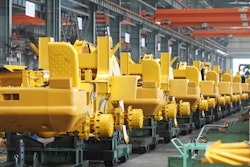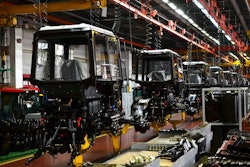
The manufacturing sector continues to be robust, despite higher prices, inflation and workforce shortages, according to the latest Manufacturing ISM Report on Business.
The Manufacturing PMI, or the Purchasing Managers’ Index, is a set of economic indicators based off surveys of private-sector companies. The report was issued July 1 by Timothy R. Fiore, chair of the Institute for Supply Management (ISM) Manufacturing Business Survey Committee.
“The June Manufacturing PMI registered 60.6%, a decrease of 0.6 percentage point from the May reading of 61.2%,” Fiore says. “This figure indicates expansion in the overall economy for the 13th month in a row after contraction in April 2020.”
The New Orders Index registered 66%, decreasing 1 percentage point from the May reading of 67%. The Production Index registered 60.8%, an increase of 2.3 percentage points compared to the May reading of 58.5%. The Prices Index registered 92.1%, up 4.1 percentage points compared to the May figure of 88% and the index's highest reading since July 1979 (93.1%).
The Backlog of Orders Index registered 64.5%, 6.1 percentage points lower than the May reading of 70.6%. The Employment Index registered 49.9%; 1 percentage point lower compared to the May reading of 50.9%. The Supplier Deliveries Index registered 75.1%, down 3.7 percentage points from the May figure of 78.8%. The Inventories Index registered 51.1%, 0.3 percentage point higher than the May reading of 50.8%. The New Export Orders Index registered 56.2%, an increase of 0.8 percentage point compared to the May reading of 55.4%. The Imports Index registered 61%, a 7 percentage point increase from the May reading of 54%.
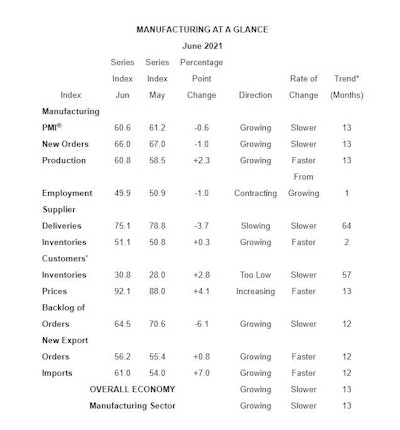 New orders and production are increasing, while employment is contracting, according to the ISM PMI Manufacturing report for June.Institute for Supply Management
New orders and production are increasing, while employment is contracting, according to the ISM PMI Manufacturing report for June.Institute for Supply Management
“Business Survey Committee panelists reported that their companies and suppliers continue to struggle to meet increasing levels of demand,” he says. “Record-long raw-material lead times, wide-scale shortages of critical basic materials, rising commodities prices and difficulties in transporting products are continuing to affect all segments of the manufacturing economy. Worker absenteeism, short-term shutdowns due to parts shortages, and difficulties in filling open positions continue to be issues that limit manufacturing-growth potential.”
Optimistic panel sentiment remained strong, with 16 positive comments for every cautious comment. Demand expanded, with the New Orders Index growing, supported by the New Export Orders Index continuing to expand, Customers' Inventories Index continuing at very low levels and Backlog of Orders Index continuing at a very high level.
Consumption (measured by the production and employment indexes) improved in the period, posting a combined 1.3- percentage point increase to the Manufacturing PMI calculation. The Employment Index, which held back further expansion, contracted after six straight months of expansion, as panelists continued to note significant difficulties in attracting and retaining labor at their companies' and suppliers' facilities. Inputs — expressed as supplier deliveries, inventories, and imports — continued to support input-driven constraints to production expansion, at higher rates compared to May, due to continued trouble in supplier deliveries. The Prices Index expanded for the 13th consecutive month, indicating continued supplier pricing power and scarcity of supply chain goods.
"All of the six biggest manufacturing industries: computer and electronic products; chemical products; fabricated metal products; transportation equipment; food, beverage and tobacco products; and petroleum and coal products, in that order — registered moderate to strong growth in June,” Fiore says. “Manufacturing performed well for the 13th straight month, with demand, consumption and inputs registering growth compared to May. Panelists' companies and their supply chains continue to struggle to respond to strong demand due to the difficulty in hiring and retaining direct labor. Continued high backlog levels, too low customers' inventories and record raw materials lead times are being reported. Labor challenges across the entire value chain continue to be the major obstacles to increasing growth.”
Seventeen of 18 manufacturing industries reported growth in June, in the following order: furniture and related products; machinery; electrical equipment, appliances and components; computer and electronic products; plastics and rubber products; chemical products; fabricated metal products; transportation equipment; miscellaneous manufacturing; nonmetallic mineral products; textile mills; primary metals; food, beverage and tobacco products; paper products; printing and related support activities; wood products; and petroleum and coal products.
“Customer demand remains strong,” a survey respondent in the machinery sector reported. “Supply chain issues continue to hamper materials availability and impact production scheduling. Supplier costs continue to rise due to increasing materials, labor and shipping costs.”
“Demand continues to be strong, and customer-ordering patterns are shifting to include long-term demand,” said a respondent from the fabricated metal products sector. “Customers are now placing orders for fourth quarter 2021 and first quarter 2022 due to global supply chain issues.”
Commodities up in price include: acrylonitrile butadiene styrene (ABS), used to make molded products such as pipe and hard hats; aluminum; aluminum products; brass; caustic soda; coatings; copper; copper products; copper wire; corn; corrugate; corrugated packaging; crude oil; diesel fuel; electric motors; electrical components; electronic assemblies; electronic components; epoxy resin; foam products; freight; high-density polyethylene (HDPE); labor — temporary; lubricants; lumber; maintenance repair operations (MRO) items; ocean freight; packaging supplies; paper; plastic resins; polyethylene; polypropylene; polyvinyl chloride (PVC) products; precious metals; resin-based products; rubber products; semiconductors; soybean products; steel; steel - carbon; steel - cold rolled; steel - galvanized; steel - hot rolled; steel - plate; steel - scrap; steel - sheet; steel - stainless; steel products; wood; wood pallets and wood products.
“The Manufacturing PMI continued to indicate strong sector expansion and U.S. economic growth in June,” Fiore says. “Four out of five subindexes that directly factor into the Manufacturing PMI were in growth territory.”
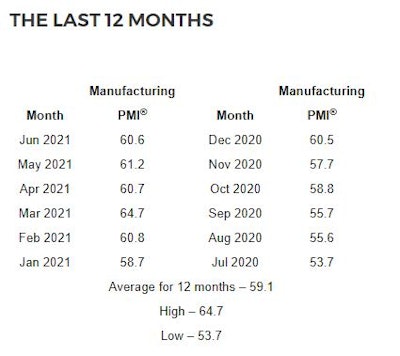 The past 12 months of the Manufacturing PMI.Institute for Supply Management
The past 12 months of the Manufacturing PMI.Institute for Supply Management
All of the six biggest manufacturing industries expanded, in the following order: computer and electronic products; chemical products; fabricated metal products; transportation equipment; food, beverage and tobacco products; and petroleum and coal products.
The New Orders and Production indexes continued to expand at strong levels. The Supplier Deliveries Index continued to reflect suppliers' difficulties in maintaining delivery rates, due to a lack of direct labor, transportation challenges and increased demand. Nine out of 10 subindexes were positive for the period; a reading of 'too low' for Customers' Inventories Index is considered a positive for future production," says Fiore. A reading above 50% indicates that the manufacturing economy is generally expanding; below 50% indicates that it is generally contracting.
A Manufacturing PMI above 43.1%, over a period of time, generally indicates an expansion of the overall economy. Therefore, the June Manufacturing PMI indicates the overall economy grew in June for the 13th consecutive month following contraction in April 2020.
“The past relationship between the Manufacturing PMI and the overall economy indicates that the Manufacturing PMI for June (60.6%) corresponds to a 5% increase in real gross domestic product (GDP) on an annualized basis,” Fiore says.
Prices Index
The ISM Prices Index registered 92.1%, an increase of 4.1 percentage points compared to the May reading of 88%, indicating raw-materials prices increased for the 13th consecutive month.
This is the index's highest level since July 1979 (93.1%) and the sixth straight month above 80%.
“Virtually all basic and intermediate manufacturing materials are experiencing price increases as a result of product scarcity and the dynamics of supply and demand, with an increasing number of panelists reporting higher prices compared to May,” Fiore says.
A Prices Index above 52.7%, over time, is generally consistent with an increase in the Bureau of Labor Statistics (BLS) Producer Price Index for Intermediate Materials.
In June, all 18 industries reported paying increased prices for raw materials, in the following order: apparel, leather and allied products; petroleum and coal products; textile mills; printing and related support activities; primary metals; nonmetallic mineral products; electrical equipment, appliances and components; furniture and related products; plastics and rubber products; fabricated metal products; machinery; paper products; miscellaneous manufacturing; food, beverage and tobacco products; transportation equipment; computer and electronic products; chemical products; and wood products.
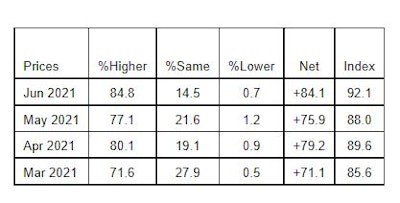 ISM Prices Index.Institute for Supply Management
ISM Prices Index.Institute for Supply Management





